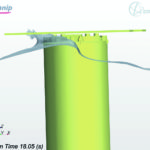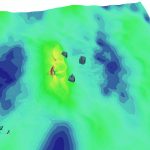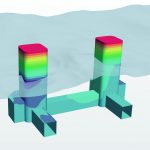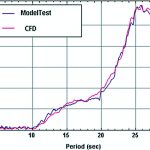Technip has introduced the Euler Overlay Method to reduce the computational cost of the NWT to make it practical for hull structural design
Advanced features of STAR-CCM+, such as Volume Of Fluid (VOF), DFBI and overset grid techniques, have made it possible[ds_preview] to simulate extreme waves and their interaction with floating structures to provide essential design information such as wave run up, air gap, green water and wave impact load. However, the application of the Numerical Wave Tank (NWT) for floater design remains challenging due to its computational cost, especially for the simulation of the floater response in irregular waves.
Simulation of irregular waves by a NWT requires a computational domain large enough to simulate nonlinear evolution of the incoming waves with sufficient fetch length. Fine mesh or cell size is needed along the fetch length to prevent excessive numerical attenuation of the incoming wave. On the downstream, sufficient domain length with damping zone is necessary to prevent wave reflection. All of these requirements make the computation cost of the NWT extremely expensive for practical application.
Recently, Technip introduced the Euler Overlay Method (EOM) to reduce the computational cost of the NWT to make it practical for hull structural design. The hybrid numerical method matches a pre-defined wave solution at far field with a CFD solution near the structure. The far-field wave solution is either regular or irregular transient waves obtained by an Euler equation solver without the presence of the structure. The EOM-based NWT has been utilized in a number of offshore projects to provide extreme design load on structures, which were available only from physical model tests in the past.
A sample of the applications of EOM in the design cycle at Technip is shown below:
Wave run up and air gap analysis
Technip uses a hybrid method utilizing MLTSIM and Star-CCM+ to calculate air gap on Spar platforms and to design hull appurtenances to prevent run up and air gap. The air gap estimated from full 3-hr MLTSIM simulation is first used to identify wave events that may cause negative air gap. The screened extreme events are simulated in Star-CCM+ with moving mesh with prescribed input wave and Spar motion from MLTSIM simulation. Air gap due to water spray can be easily filtered out by inspecting volume fraction in the prescribed area below the top free surface.
Ringing analysis for gravity based structure
Ringing is a phenomenon experienced by tension-leg and steel gravity based structures (GBS) when responses of considerable amplitude are generated by these structures at their resonance period and higher harmonics, potentially causing hull strength and fatigue issues during extreme wave events. EOM was applied to a ringing analysis of a new gravity based platform subjected to short-crested irregular waves. Model tests for this GBS were problematic with providing pressure distribution over the hull for the dynamic structural analysis. CFD analysis with EOM enabled proper study of this GBS at higher-harmonic loading by providing time history of pressure distribution over the hull, which is fed into dynamic structural analysis model. Numerical computations show the dynamic amplification of the structural response due to the resonant dynamic response of the structure to higher-harmonic loads.
Semi-submersible motion simulation
The EOM was used for motion analysis of a semi-submersible platform in the design phase. Model tests offered data on heave response amplitude operators (RAO), to evaluate the performance of the platform in waves. Numerical analysis with the EOM model shows excellent prediction of heave RAO for the semi-submersible. The validated EOM model has been utilized to evaluate performance of more optimized platform design.
Conclusion
The EOM has also been used successfully in performance evaluation and optimization of various offshore platforms including Spar, GBS, TLP and semi-submersible at Technip. The above examples show the value of simulation as an effective replacement for model tests early in the design phase to identify the more optimal offshore platform designs before moving to model tests, thereby reducing time and cost of model tests and shortening the design time. CFD can be used after model testing to extend the design into variations that shorten the overall optimization process. In addition, simulation provides more information on the physics involved compared to model tests. The return on investment for simulation is extremely high for design of offshore platforms. With improved wave models and mooring/riser modeling, Technip intends to reap greater benefits from using numerical simulation in the design cycle.
Please note: A long version of this article is available at our website www.hansa-online.de (rubric »Fachartikel«).
Authors:
Jang Whan Kim, Hyunchul Jang,
Jim O’Sullivan, all at Technip USA
www.technip.com
Jang Whan Kim, Hyunchul Jang, Jim O’Sullivan






















